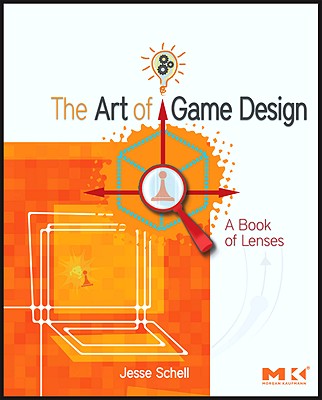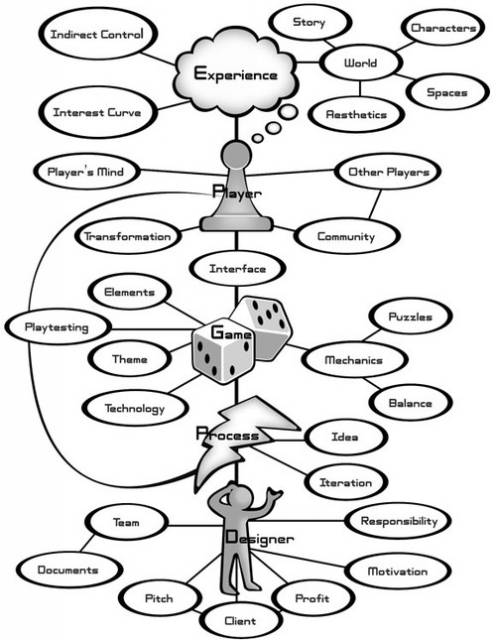A Few Notes on A Book of Lenses
By nintendoeats 11 Comments

As many of you know, I am attempting to break into the field of professional game design. I have done, and am actively doing, many things in service of that goal. One of them is reading Jesse Schell’s “The Art of Game Design: A Book of Lenses.” It sat in a place of prominence for months before I was finally presented with large sections of time in which I had nothing to do but sit in a dark room and not make any noise. Having finished my most recent Orwell I decided to finally take the 464 page book and finish it. I just did so, and given that I have some time to kill anyway I felt it was worth doing a little write-up. This isn’t a review as the book is an industry standard and I don’t feel qualified to judge it. Instead, this is a short commentary on 4 subjects: What it covers, Its general attitude, how it has been useful to me, and the perspective that it can give to game players who are NOT trying to actually conduct game design
What Book of Lenses Covers
Schell doesn’t do this, but having now read the book I feel comfortable breaking it into 4 general sections:
1. How do think about design
2. How to think about designing games
3. How to get games made
4. How to get games made given the current nature of the industry
We could get into some discussion about where each of those sections starts (again, these are completely my creation) but if you only wanted to know about one I would feel comfortable telling you which chapter to start on. The titular lenses are paradigms for looking at each of these topics (why he felt the need to make exactly 100 of them I don’t know), each of which are summarized in little boxes that one could easily pepper about their workspace for inspiration.
The first section is a general introduction to basic design concepts like unity and various ways of analyzing design. This section is very short and is more of a basis to work from than an in-depth account of design.

The second section is by far the longest and gives you enough of an understanding of everything that it talks about that you can go off and learn the intimate details on your own. This includes creating unity of design among all of the different elements of games, thinking about players, mechanics, game balancing, designing spaces and a wealth of other things. I don’t know that anybody who doesn’t know much about pre-existing video games would be able to make much of any of these things, but I could instantly apply things that he was saying to games that I had played, heard about and worked on. If all you care about is the nitty gritty of game design, chapters 10-21, but the preceding chapters are vital to a complete understanding of the subject.
The chapters dealing with “getting games made” are primarily about working with teams, staying organized, communicating ideas and keeping everything working given available resources. Finally, the fourth sections are about the business realities of the games industry and how to realistically manage the impact that they have on making games.
The last few chapters are a space where Schell can bring the rest of the book together. They are more about the social impact of games than they are about how to make them. They include the responsibilities that he perceives game designers having, the way that games can affect social change, and the possible future of the medium.
Schell’s Tone and Attitude
A recent issue of Game Developer listed Jesse Schell as one of their top video game evangelists of 2011, with an emphasis on his push for games as a catalyst for social change. This comes across strongly in the book. He deals with game design on a very broad level, taking it to mean the crafting of complete experiences that can deeply impact player. Each section is geared towards developing the best player experiences possible, except for those in the final section that deal with how to do that while still dealing with outside pressures.

This holistic attitude requires that he reference sources from a wide variety of fields. This ranges from obvious things like architecture and theater to more esoteric things like people he worked with when he was a professional juggler. As much as this can occasionally feel a little contrived, it does give quite a bit of credibility to Schell’s statement at the end of the book that video games are “the medium that will subsume all others.” If you have any love of video games, it is hard to not get excited by this approach.
Fortunately Schell does not forget that this is a practical book. He does not act as though the realities of the industry don’t exist, hence the third and fourth sections of the book. He could easily have written a book about game design without these sections, but it would not have been the complete text that made it an industry standard. It also serves to let you know that Schell’s ideas can be implemented, and that his advice is not pie-in-the-sky rambling.
How Book of Lenses Has Affected Me
As a philosophy major, I have come to have certain expectations from texts that I plan to actually think about and use:
- They will reinforce and hone some of my ideas and viewpoints, hopefully giving me new ways to use them
- They will convince me that some of my ideas are misguided, preferably by giving me a way and a reason to alter or replace them
- They will contain a few points on which I respectfully disagree and which I can formulate complete and non-obvious arguments against
Book of Lenses has all of these features. Part of the reason that it took me so long to start reading it in earnest is that I found the early parts to be so blatantly obvious that I wasn’t learning anything, even though I knew that the later sections were full of useful tools and information. However, immediately after the section that I had originally stopped on the book began to take ideas that I had and really hone them. It was a very satisfying feeling to know that many of the ideas that I had independently come up with about game design were in the book, but it wasn’t until I saw them organized in this methodical fashion that they went from general notions to proper analytical tools.
To the same degree, I had to sacrifice many notions that I had. For example, I joined many in believing that multiplayer games aren’t really as much work to design as single-player experiences (with the obvious exception of games balanced for high-level play). Schell convinced me otherwise fairly easily. This ultimately caused me to change the goal of my current project in both tangible and subtle ways.
The book also taught me a great deal about how this industry works. I now feel much more confident that I can talk to somebody within the industry and understand what they go through. I can also see the component parts of games and how they came to be the way that they are. Perhaps most importantly of all, I have a greater appreciation for the fact that games which appeal to the tiny niche that we occupy get made at all.
Of course it is hard for me to sort out exactly what changes in perspective have come from Schell and which are a result of my own work and having had a chance to interact with real game developers. In reality is a confluence of all these things. I saw my project before as being developing games with an emphasis on narrative. I now have a very different goal: to learn as much as I can about traditional game design so that when the opportunity presents itself I can begin to violate rules to make something that is unique, compelling and hopefully changes the people who play it. Of course, in an industry that moves this fast I’m not sure that there is such a thing as traditional game design anymore. If not, that just means that there is more of an infrastructure out there to help me do something new!
How Book of Lenses Might Affect You
I have allowed my more design-oriented self speak, and now I’m going to give the microphone to the part of me that just likes playing games for fun (he himself has been relegated to a tool for some time now, but he does represent a typical audience to some degree). He will tell you briefly how you might find portions of Schell’s book interesting and useful even if you don’t give a sod about actually designing games.

To begin with, the most obvious: if you see a design element you can actually figure out why it’s there! This is especially helpful if it is something that annoys you, because it might allow you to actually enjoy the feature. Of course this is a double-edged sword: That other design oriented guy that lives in my head is always running my fun by stressing over design elements. If you don’t think that you can shut him up and just enjoy a game you should tread carefully with this, or really any game design book.

Another double-edged sword is what this book does to your perspective on how games get made. On the one hand, it’s depressing to know that when games get to you they have gone through all these business filters that can potentially make them worse. However, Schell gives the impression that really great designers are doing everything that they can to circumvent these forces and give you what you really want. People who care enough about games to actively educate themselves about them are a small group. It is only because the people who make games love them as much as we do that even games aimed at the mass market are designed to appeal to us. I cannot envision a day when this isn’t true, so there will always be games out there for us.
Perhaps the most important thing that Book of Lenses might do for you is to bring you closer to the people who make games. When you understand the details of the process, you suddenly have shared knowledge with the people who make the things that you love. That knowledge becomes a shared experience, and through games you can develop a stronger (though of course still one-way) relationship with those people. And hey, if you know what they have gone through you can provide more thoughtful and useful criticism when a game designer makes a decision that you disagree with! Good designers care about what you think, and if you can provide meaningful feedback you might actually make a game that you care about better!
With All of that Said
God damn this has gotten long. If you actually got through all of that I thank you for taking the time to listen to me. This book left a strong enough impression on me that I felt the need to write a bit about it, I didn’t realize that I had this much to say! I tried to keep this as broad and cursory as possible, so I’m ready and waiting for any questions or comments. If everything goes according to plan, after Christmas break I will be ready to show some material about the project that I referred to.
GLHB
Nintendoeats
11 Comments